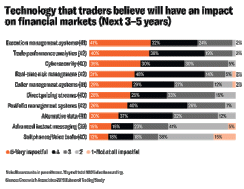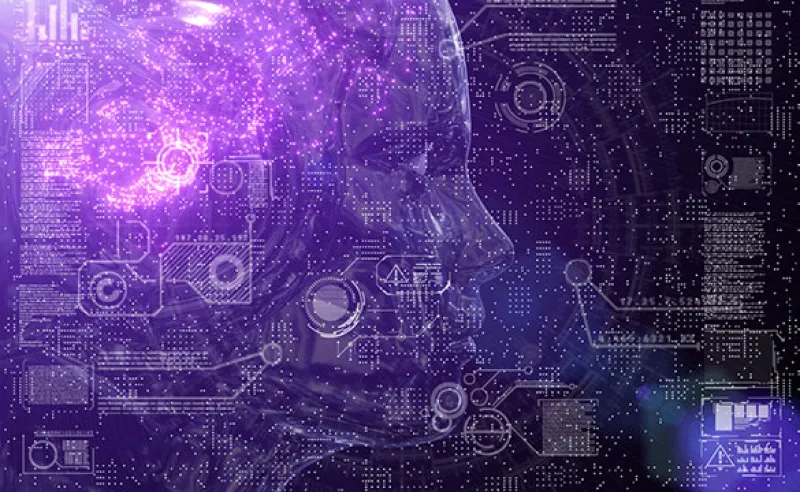Trading has certainly been the area of investing most directly disrupted by technology, and that disruption shows no signs of ebbing. A typical trading desk in a few years might not look much different than it does today – but it will almost certainly function in a significantly smarter fashion for traders who will be expected to do more, as well.
To gain insight into how these changes might unfold, Refinitiv partnered with Greenwich Associates to produce a three-part research series called The Future of Trading. The survey of 107 capital markets professionals globally provides the foundation for an examination of the changes in technology driving the trading desk, the data explosion and what it means for future workflows, and how the relationships between trading professionals are evolving. II recently sat down with Michael Chin, Managing Director and Global Head of Trading Proposition at Refinitiv, to discuss the first report’s findings regarding AI, big data, and analytics on the trading desk.
II: What are some of the tech advancements you see as having the biggest impact on trading and traders over the next five years or so?
Michael Chin: The critical component will remain the EMS [execution management system], albeit a smarter iteration of it. Traders’ workload has to be augmented with automation because they are expected to be true multi-asset-class traders while proving their value, achieving best execution, complying with regulatory demands, and so on. To do that they’ll need an enhanced EMS with smart order routing that bypasses the human trader on certain trades, based upon parameters the trader is comfortable with, such as trade size, sector, time of day, liquidity – all while the machine continues to learn from the trader’s choices of brokers and algorithms in terms of best results and best execution. The traders themselves will also need smart tools to expand their scope and be able to manage cross asset-trading with minimal spread risk.

How will these changes affect the buy side and sell side?
We have seen the buy side become much more comfortable and confident incorporating machine learning and AI into their algorithmic trading strategy suite, and using these algos more. On the sell side we’re seeing a greater dependency on collaboration tools to increase productivity. With smart CRM [customer relationship management] tools we’re seeing a lot more auto-recommendations being sent out to clients based on signals in the market that align with their portfolios and trading history. All of this is happening in real time – gone are the days of sales traders dialing up all their clients on the phone.
Key Findings from The Future of Trading: Technology in 2024 report: Artificial intelligence/machine learning is expected to have the biggest impact on global capital markets.
- 61% of survey participants are using artificial intelligence (including machine learning) now; (44%) or expect to be within 12-24 months (17%).
- AI is overwhelmingly seen as the most potentially disruptive technology. This perception is stronger among Millennials (2 out of 3) than GenXers (half).
- The perceived potential for AI to be very disruptive is 50% higher than that of cloud computing.
- AI is already affecting the trading process via algorithmic trading and facilitating analysis of data, content, news, etc.
- Only 1 in 5 asset managers or hedge funds are using some AI today, and prefer to let vendors and trading counterparties make the investment.
- While 4 of 5 participants expect AI/machine learning to be fully integrated into the trading process in the next 3-5 years, driving increases in returns, performance, and efficiency – only 44% are using AI today.
How are analytics evolving to support transaction cost analysis and trade performance analysis?
We’re building a deeper suite of analytic tools for clients who need to support trading decisions before the actual trade takes place. We’re investing in everything involved in pre-trade. With the recent acquisition of AlphaDesk [a cloud-based OMS for buy-side clients], we now have the core workflow tools, so it’s really a matter of linking and connecting all the rich content and data we have, including the pre-trade workflow tools we have in Eikon. We never stop asking how we can help traders better manage the reams of data they’re exposed to.
Presumably that flow of data is only going to increase, adding to the challenge for traders?
That’s right, and that helps drive new solutions. For example, historically the market data terminal business has relied on traders to seek out pre-trade information, connect all the dots, and figure out the right signals to help make trading decisions – all with minimal help and time savings from automated suggestions. We’re currently putting the finishing touches on a machine-learning-based solution that is all about faster insight. Think of it as a smart desktop that, when there is a significant movement in the market, identifies anomalies or trading spikes and starts mapping back in real time to help pinpoint why that trade spike or anomaly happened. On the surface, that’s post-trade analysis, but every time an anomaly is identified the smart desktop is learning something about the reason behind it, and feeding that reasoning into an analytics engine, which is learning and then becoming more predictive. To us, that’s the future.
Machine learning and AI play a big part in what you just described. How disruptive do you anticipate AI becoming in trading beyond the effect its already had?
At the heart of the Greenwich report we are seeing much more openness on incorporating some form of AI into the trading workflow – it’s sort of taking over. I don’t find that surprising. There is a sort of generational dynamic involved, and Millennials are much more open to AI and machine learning – they’re interacting with it every day on social media, and in how stores and retailers are reaching out to them based upon their particular buying habits and so forth. They’re much more comfortable with it. Since they will be the traders of the future, we’ll likely continue to see more of a shift towards accepting AI and machine learning in the coming years. As a result, we are really focused on how we can incorporate AI to advance the workflows that we offer to our clients. And from a trader’s perspective there are tangible achievements or objectives – quality of trades and best execution, for example – that a trader is going to focus on when it comes to expecting their solution providers to incorporate machine learning. In today’s world, the portfolio manager and trader functions are becoming more entangled, and the line of demarcation between the two has become murky. The need to integrate all the solutions and create an ecosystem that everyone can use is driving Refinitiv’s strategy.
Will the smart desktop be able to leverage alternative data?
Yes. We’ve always had a very strong alternative data offering on the commodities side of the business, and we’re working with a number of partners to help expand our overall alternative data offering across other asset classes. We’ll stop short of launching a satellite to capture alternative data; but we are focused on assembling the best possible alternative data sets with our partners. In turn, those data sets will be part of the rich data offering that is fed into the smart desktop we’re developing, to be dissected, analyzed, and presented to our clients.
Learn more about the future of trading and your trading desk.
© Refinitiv 2020. All Rights Reserved.





